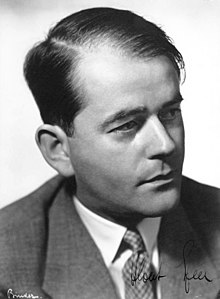Our website is made possible by displaying online advertisements to our visitors.
Please consider supporting us by disabling your ad blocker.
Albert Speer
Albert Speer | |
|---|---|
 Speer in 1933 | |
| Reich Minister of Armaments and War Production[a] | |
| In office 8 February 1942 – 30 April 1945 | |
| Führer | Adolf Hitler |
| Preceded by | Fritz Todt (as Minister of Armaments and Munitions) |
| Succeeded by | Karl Saur (as Minister of Munitions) |
| Reich Minister of Industry and Production | |
| In office 5 May 1945 – 23 May 1945 | |
| Head of state | Karl Dönitz |
| Head of government | Lutz Graf Schwerin von Krosigk |
| Preceded by | Position established |
| Succeeded by | Position abolished |
| Inspector General of German Roadways | |
| In office 8 February 1942 – 23 May 1945 | |
| Preceded by | Fritz Todt |
| Succeeded by | Position abolished |
| Inspector General for Water and Energy | |
| In office 8 February 1942 – 23 May 1945 | |
| Preceded by | Fritz Todt |
| Succeeded by | Position abolished |
| Head of Organization Todt | |
| In office 8 February 1942 – 14 April 1944 | |
| Preceded by | Fritz Todt |
| Succeeded by | Franz Xaver Dorsch |
| General Building Inspector for the Reich Capital | |
| In office 30 January 1937 – 23 May 1945 | |
| Preceded by | Position created |
| Succeeded by | Position abolished |
| Personal details | |
| Born | Berthold Konrad Hermann Albert Speer 19 March 1905 Mannheim, Grand Duchy of Baden, German Empire |
| Died | 1 September 1981 (aged 76) London, England |
| Political party | Nazi Party (1931–1945) |
| Education | Technische Universität Berlin Technical University of Munich University of Karlsruhe |
| Profession | Architect, government official, author |
| Cabinet | Hitler cabinet Schwerin von Krosigk cabinet |
| Signature |  |
| Criminal conviction | |
| Conviction(s) | War crimes Crimes against humanity |
| Trial | Nuremberg trials |
| Criminal penalty | 20 years imprisonment |
| Details | |
| Target(s) | Millions of slave laborers; Soviet prisoners of war and others |
| Imprisoned at | Spandau Prison |
Berthold Konrad Hermann Albert Speer (/ʃpɛər/; German: [ˈʃpeːɐ̯] ⓘ; 19 March 1905 – 1 September 1981) was a German architect who served as the Minister of Armaments and War Production in Nazi Germany during most of World War II. A close ally of Adolf Hitler, he was convicted at the Nuremberg trials and sentenced to 20 years in prison.
An architect by training, Speer joined the Nazi Party in 1931. His architectural skills made him increasingly prominent within the Party, and he became a member of Hitler's inner circle. Hitler commissioned him to design and construct structures, including the Reich Chancellery and the Nazi Party rally grounds in Nuremberg. In 1937, Hitler appointed Speer as General Building Inspector for Berlin. In this capacity he was responsible for the Central Department for Resettlement that evicted Jewish tenants from their homes in Berlin. In February 1942, Speer was appointed as Reich Minister of Armaments and War Production. Using misleading statistics, he promoted himself as having performed an armaments miracle that was widely credited with keeping Germany in the war.[1] In 1944, Speer established a task force to increase production of fighter aircraft. It became instrumental in exploiting slave labor for the benefit of the German war effort.
After the war, Albert Speer was among the 24 "major war criminals" charged by the International Military Tribunal for Nazi atrocities. He was found guilty of war crimes and crimes against humanity, principally for the use of slave labor, narrowly avoiding a death sentence. Having served his full term, Speer was released in 1966. He used his writings from the time of imprisonment as the basis for two autobiographical books, Inside the Third Reich and Spandau: The Secret Diaries. Speer's books were a success; the public was fascinated by the inside view of the Third Reich he provided. He died of a stroke in 1981.
Through his autobiographies and interviews, Speer carefully constructed an image of himself as a man who deeply regretted having failed to discover the crimes of the Third Reich. He continued to deny explicit knowledge of, and responsibility for, the Holocaust. This image dominated his historiography in the decades following the war, giving rise to the "Speer myth": the perception of him as an apolitical technocrat responsible for revolutionizing the German war machine. The myth began to fall apart in the 1980s, when the armaments miracle was attributed to Nazi propaganda. Twenty-five years after Speer's death, Adam Tooze wrote in The Wages of Destruction that the idea that Speer was an apolitical technocrat was "absurd". Martin Kitchen, writing in Speer: Hitler's Architect, stated that much of the increase in Germany's arms production was actually due to systems instituted by Speer's predecessor (Fritz Todt) and that Speer was intimately aware of and involved in the "Final Solution"; evidence of which has been conclusively shown in the decades following the Nuremberg trials.
Cite error: There are <ref group=lower-alpha> tags or {{efn}} templates on this page, but the references will not show without a {{reflist|group=lower-alpha}} template or {{notelist}} template (see the help page).
- ^ Kitchen 2015, pp. 174–175.
Previous Page Next Page


